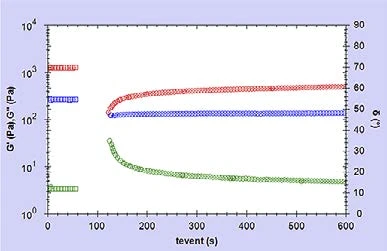Introduction
Many consumer products are packaged in tubes or bottles where product application involves pumping the product through a nozzle. Such products tend to be shear-thinning products where the viscosity drops during the extrusion process due to the increasing shear rate, and then recovers on exiting the orifice as the shear rate is reduced. The shear rate encountered during this process is related to the radius, r of the orifice and the volumetric flow rate Q by the following expression:

The parameter n is the power law index, which is 1 for a Newtonian liquid and between 0-1 for a Non-NewtonianA non-Newtonian fluid is one that exhibits a viscosity that varies as a function of the applied shear rate or shear stress.non-Newtonian fluid. This value can be readily attained from a variable shear rate test by fitting a Power Law ModelThe power law model is a common rheological model to quantify (typically) the shear thinning nature of a sample, with the value closer to zero indicating a more shear thinning material.power law model to the resultant data.
By measuring the volumetric flow rate (volume dispensed in given time) and the internal radius of the orifice, it is possible to estimate the shear rate encountered during extrusion.
Because many consumer products including foodstuffs, coatings and toiletries/cosmetics can have very delicate microstructures, these structures are easily broken down during the extrusion process and may not recover their original structure until a finite time has passed. Materials which have a time-dependent structural recovery or rebuild are termed thixotropic. By calculating the shear rate encountered during extrusion and using this in the intermediate stage of a step strain-shear rate test, it is possible to mimic structural breakdown resulting from extrusion.
By immediately following structural recovery through the Elastic modulusThe complex modulus (elastic component), storage modulus, or G’, is the “real” part of the samples the overall complex modulus. This elastic component indicates the solid like, or in phase, response of the sample being measurement. elastic modulus G’ as a function of time, it is possible to determine structural recovery of the system and ultimately the structural integrity of the product at time of use. This can be important in terms of physical appearance (slump resistance), in use texture or product functionality, for example, the ability to cling on to a vertical surface.
Experimental
- The structural recovery properties of toothpaste and a hair gel were evaluated under shear rate conditions associated with product extrusion during use.
- Rotational rheometer measurements were made using a Kinexus rotational rheometer with a Peltier plate cartridge and a roughened parallel plate measuring system1, and using standard pre-configured sequences in the rSpace software.
- A standard loading sequence was used to ensure that both samples were subject to a consistent and controllable loading protocol.
- All rheology measurements were performed at 25°C.
- The relevant extrusion shear rates were automatically calculated as part of the test sequence using inputted values of extruded volume, extrusion time and aperture radius. The test was programmed to use this calculated value as the intermediate shear rate in a step shear rate test with step 1 and step 2 employing a constant strain value within the samples Linear Viscoelastic Region (LVER)In the LVER, applied stresses are insufficient to cause structural breakdown (yielding) of the structure and hence important micro-structural properties are being measured.LVER at a frequency of 1Hz.
- The time to recover 90% of the products original elasticity (G’) was automatically determined and reported at the end of the test.


Results and Discussion
The automatic calculator evaluated the shear rate in the extrusion process to be 86 s-1 for the toothpaste and 240 s-1 for the hair gel. These values were used in the intermediate shear rate stage of the test.
Figure 1 shows the results for the toothpaste. Clearly, this is a highly thixotropic material as observed from the recovery curve which shows it does not fully recover its structure in the timescale of the test, reaching only 50% of its original value of G’ after approximately 500 seconds.
Conversely, the hair gel (Figure 2) recovers its structure almost instantaneously with 90% of recovery occurring in the first 5 seconds and completes recovery within 20 seconds. This is important for this product as it needs to provide instantaneous hold to the hair before the resin can form an elastic film for longer-term hold.
Note both materials appear to show Yield StressYield stress is defined as the stress below which no flow occurs; literally behaves like a weak solid at rest and a liquid when yielded.yield stress behavior at the frequency measured since G’ exceeds G” indicating an interconnected or solid-dominant microstructure.
Conclusion
A three-step strain/shear rate test was performed on a toothpaste and hair gel to evaluate the rate and extent of elasticity recovery following extrusion from a tube. The toothpaste was shown to be highly thixotropic taking 500 seconds to recover 50% of its original elasticity while the hair gel recovered almost immediately.
Please note...
that testing is recommended to be performed with cone and plate or parallel plate geometry - with the latter being preferred for dispersions and emulsions with large particle sizes. Such material types may also require the use of serrated or roughened geometries to avoid artefacts relating to slippage at the geometry surface.